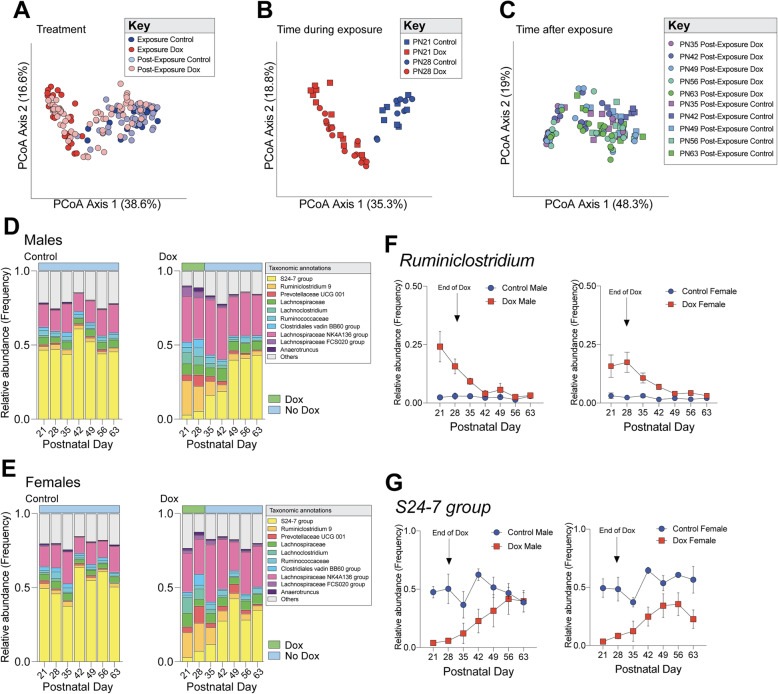Fig. 3.
Doxycycline disruption of offspring metabolism is associated with lasting alterations to the offspring gut microbiota. a Principal coordinates analysis comparing fecal microbial community structure in male and female offspring from Control and Dox groups throughout the duration of collection postnatal day 21 to 63. Doxycycline treatment significantly drives community structure. (PERMANOVA, F = 42.772, r2 = 0.22304, P < 0.001). b Principal coordinate analysis comparing fecal microbial community structure in Dox offspring compared to controls during doxycycline exposure postnatal day 21 to 28. Doxycycline significantly drives community structure in offspring (PERMANOVA, F = 27.176, r2 = 0.39286, P < 0.001). c Principal coordinate analysis comparing fecal microbial community structure of Dox offspring compared to controls after exposure to doxycycline ends. Doxycycline still drives community structure in a number of Dox samples, however, communities shift to become more like Controls as they reach postnatal day 63 (PERMANOVA, F = 26.046, r2 = 0.19876, P < 0.001). d Stacked bar plots show the average relative abundance of the ten most-abundant taxa in Dox and Control male offspring during doxycycline exposure at postnatal day 21 and 28 and post-DOX exposure at postnatal day 35 to 63. Dox exposed offspring show major differences in community composition particularly a loss of Bacteroidetes and a simultaneous bloom of Firmicutes. e Stacked bar plots show the average relative abundance of the ten most-abundant taxa in Dox and Control female offspring during doxycycline exposure at postnatal day 21 and 28 and post-DOX exposure at postnatal day 35 to 63. f Ruminiclostridium is significantly changed in males over time (two-way ANOVA, main effect of time, F6, 51 = 4.1063, P = 0.0066), by doxycycline treatment (two-way ANOVA, main effect of treatment, F1, 9 = 11.6871, P = 0.0076), and their interaction (two-way ANOVA, time x treatment interaction, F6, 51 = 3.8514, P < 0.05). In females, Ruminiclostridium was significantly changed over time (two-way ANOVA, main effect of time, F6, 54 = 3.471, P = 0.0057), by treatment (two-way ANOVA, main effect of treatment, F1, 9 = 13.78, P = 0.0048) and their interaction (two-way ANOVA, time x treatment interaction, F6, 54 = 2.578, P = 0.0287). Post hoc analysis revealed that bloom of Ruminiclostridium during active Dox exposure was reduced after exposure ended. Male: (Sidak’s multiple comparisons, t60 = 1.594, P = 0.6344), Female: (Sidak’s multiple comparisons, t63 = 2.115, P = 0.2398). g S24-7 group shows temporal patterns during doxycycline exposure and post-exposure. In males, abundance of S24-7 was significantly changed by treatment (two-way ANOVA, main effect of treatment, F1,9 = 12.3622, P = 0.0066). Post hoc analysis revealed that this taxon increased to control levels by postnatal day 63 (Sidak’s multiple comparisons, t60 = 0.0641, P > 0.999). S24-7 in females was significantly changed over time (two-way ANOVA, main effect of time, F6, 54 = 3.1799, P = 0.0096) and by treatment (two-way ANOVA, main effect of treatment, F1, 9 = 33.3202, P = 0.0003) with incomplete recovery at postnatal day 63 (Sidak’s multiple comparisons, t63 = 2.9151, P = 0.0339). Relative abundance for F and G is reported as mean frequency ± SEM. 4–7 samples per sex, treatment, and timepoint were used for analyses

